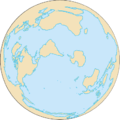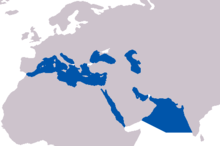Seven Seas
The "Seven Seas" (as in the idiom "sail the Seven Seas") is an ancient phrase for all of the world's oceans.[1] Since the 19th century, the term has been taken to include seven oceanic bodies of water:[2][3]
- the Arctic Ocean
- the North Atlantic Ocean
- the South Atlantic Ocean
- the Indian Ocean
- the North Pacific Ocean
- the South Pacific Ocean
- the Southern (or Antarctic) Ocean
 |
| Earth's oceans |
|---|
|
World Ocean |
The World Ocean is also collectively known as just "the sea". The International Hydrographic Organization lists over 70 distinct bodies of water called seas.[4]
Mesopotamia
The term "Seven Seas" appears as early as 2300 BC in Hymn 8 of the Sumerian Enheduanna to the goddess Inanna.[5] The Mesopotamians were the first in the history of astronomy to keep records of the observed seven moving objects in the heavens – the seven Classical Planets/Seven Heavens – and they made this connection to their seven seas.[6]
Ancient Indian subcontinent
Ancient texts and legends speak of Seven Seas or Sapta Sindhu (Sopto Sindhu). Sindhu and Sagar/Sagor mean sea in different languages of the subcontinent. According to the Vishnu Purana or Bishnu Puran, the seas were Lavana/Lobon (salt), Iksu/Ikkhu (sugar-cane), Sura/Sura (wine), Sarpi (clarified butter or Ghee), Dadhi/Dodhi (yoghurt or curd), Dugdha/Dugdho (milk) and Jala/Jol (water).[7] There may be variant list of names. For example, there is also mention of a Peeta/Pit Sagara/Sagor ie Yellow Sea. The word Pita means yellow. The Kshira Sagar or Kshir Sagar or Khir Sagor is also the white Sea. The word Kshira/Khir literally means condensed milk.. However, it also denotes white like milk.
Romans
The meaning of septem maria (Latin) in Ancient Rome is different than the phrase "seven seas" in the modern era. The navigable network in the mouths of the Po river discharges into saltmarshes on the Adriatic shore and was colloquially called the "Seven Seas" in ancient Roman times. Pliny the Elder, a Roman author and fleet commander, wrote about these lagoons, separated from the open sea by sandbanks:
All those rivers and trenches were first made by the Etruscans, thus discharging the flow of the river across the marshes of the Atriani called the Seven Seas, with the famous harbor of the Etruscan town of Atria which formerly gave the name of Atriatic to the sea now called the Adriatic.[8]
A history of Venice states:
The expression "to sail the seven seas" was a classical flourish signifying nautical skill. It was applied to the Venetians long before they sailed the oceans.[9]
Arabs
The Arabs and their near neighbours considered the Seven Seas (Arabic: البحار السبعة) to be the seas that they encountered in their voyages to The East. They were trading routes in ancient times and since the time of Muhammad, they are the places where Islam spread and is widely practised.
In the 9th century AD, author Ya'qubi wrote:
Whoever wants to go to China must cross seven seas, each one with its own color and wind and fish and breeze, completely unlike the sea that lies beside it. The first of them is the Sea of Fars, which men sail setting out from Siraf. It ends at Ra’s al-Jumha; it is a strait where pearls are fished. The second sea begins at Ra’s al-Jumha and is called Larwi. It is a big sea, and in it is the Island of Waqwaq and others that belong to the Zanj. These islands have kings. One can only sail this sea by the stars. It contains huge fish, and in it are many wonders and things that pass description. The third sea is called Harkand, and in it lies the Island of Sarandib, in which are precious stones and rubies. Here are islands with kings, but there is one king over them. In the islands of this sea grow bamboo and rattan. The fourth sea is called Kalah and is shallow and filled with huge serpents. Sometimes they ride the wind and smash ships. Here are islands where the camphor tree grows. The fifth sea is called Salahit and is very large and filled with wonders. The sixth sea is called Kardanj; it is very rainy. The seventh sea is called the sea of Sanji, also known as Kanjli. It is the sea of China; one is driven by the south wind until one reaches a freshwater bay, along which are fortified places and cities, until one reaches Khanfu.[10]
This passage demonstrates the Seven Seas as referenced in Medieval Arabian literature:
- The Persian Gulf ("Sea of Fars")
- The Arabian Sea ("Sea of Larwi")[11]
- The Bay of Bengal ("Sea of Harkand")[12]
- The Strait of Malacca ("Sea of Kalah")[13]
- The Singapore Strait ("Sea of Salahit")[14]
- The Gulf of Thailand ("Sea of Kardanj")[13]
- The South China Sea ("Sea of Sanji")[13]
Arab seafarers may have also considered other important seas nearby which they navigated regularly, including the Black Sea, Caspian Sea, Red Sea, Mediterranean Sea, and Adriatic Sea.
Medieval Europe

The medieval concept of the Seven Seas has its origins in Greece and Rome. In medieval European literature, the Seven Seas referred to the following seas:
- the Adriatic Sea
- the Mediterranean Sea, including its marginal seas, notably the Aegean Sea, Ionian Sea and Tyrrhenian Sea.
- the Black Sea
- the Caspian Sea
- the Persian Gulf
- the Arabian Sea (which is part of the Indian Ocean)
- the Red Sea, including the closed Dead Sea and the Sea of Galilee
The Seven Seas in medieval times also included:
- the Atlantic Ocean
- the Aegean Sea
- the Indian Ocean
- the North Sea
Renaissance era
During the Renaissance a moderately standardized iconography of the four continents (and the corresponding four rivers) of the world was created.
Persians
The Persians used the term "the Seven Seas" to refer to the streams forming the Oxus River.[15]
Talmudists
The Babylonian Talmud mentions seven seas and four rivers that surround the land of Israel. In Tractate Bava Batra, fol. 74b, it reads:
When R. Dimi came he said R. Yohanan said: "What is the meaning of the verse, 'For he hath founded it upon the seas and established it upon the floods.' (Ps. 24:2)? This refers to the seven seas and four rivers that surround the land of Israel. And what are the seven seas? The sea of Tiberias, the Sea of Sodom, the Sea of Helath, the Sea of Hiltha, the Sea of Sibkay, the Sea of Aspamia and the Great Sea. And what are the four rivers? The Jordan, the Yarmuk, the Keramyhon and Pigah."[16][17]
According to this and other passages, the Talmudic Seven Seas include:[18]
- Sea of Tiberias (Lake Tiberias or The Sea of Galilee)
- Sea of Sodom (The Dead Sea)
- Sea of Helath (The Red Sea)
- Sea of Hiltha (Birkat Ram)
- Sea of Sibkay (Lake Hula)
- Sea of Aspamia (A lake said to be north of Apamia on the Asi River, possibly the formerly flooded Al-Ghab Plain)
- The Great Sea (The Mediterranean Sea)
Various transliterations for the sea names from Hebrew exist. For Helath: Chelath and Shelyith. For Hiltha: Chiltha and Chultha. For Sibkay: Sibchi and Somcho. And for Aspamia: Apamia.[18]
The 17th century churchman and scholar John Lightfoot mentions this set of seas in his Commentary on the New Testament. A chapter titled The Seven Seas according to the Talmudists, and the four Rivers compassing the Land includes the "Great Sea" (now called the Mediterranean Sea), the "Sea of Tiberias" (Sea of Galilee), the "Sea of Sodom" (Dead Sea), the "Lake of Samocho" (probably the (mostly) dried-up Hula Lake, called Semechonitis by Josephus and lake Sumchi in the Talmud), also called the "Sibbichaean".[19] Lightfoot does not comment on the remaining three seas.
East Indies
In British Colonial times the Clipper Ship Tea Route from China to England was the longest trade route in the world. It took sailors through seven seas near the Dutch East Indies: the Banda Sea, the Celebes Sea, the Flores Sea, the Java Sea, the South China Sea, the Sulu Sea, and the Timor Sea. The Seven Seas referred to those seas, and if someone had sailed the Seven Seas it meant he had sailed to, and returned from, the other side of the world.[20]
Early modern

After the discovery of the Americas during the Age of Discovery, the "seven seas" were reckoned by some as:[3]
- the Pacific Ocean
- the Atlantic Ocean
- the Indian Ocean
- the Arctic Ocean
- the Mediterranean Sea
- the Caribbean Sea
- the Gulf of Mexico
The last two of these are now reckoned to be part of the Atlantic Ocean, and the Mediterranean either part of the Atlantic or omitted. Splitting the Atlantic and Pacific into north and south and adding the Southern Ocean returns the list to seven.
Detailed reckonings of the divisions of the world ocean into oceans and seas is not limited to lists of seven. For example, the International Hydrographic Organization recognizes many marginal seas; some saltwater lakes and the freshwater Sea of Galilee also have "sea" in their names.
See also
- Clime
- Four Seas
- Four continents
- Karshvar
- List of seas
- Roof of the World
- Rudyard Kipling, who titled a volume of poems The Seven Seas (1896) and dedicated it to the city of Bombay.[21]
References
- The New Dictionary of Cultural Literacy (3rd ed.). Houghton Mifflin Company. 2002. Archived from the original on March 14, 2009.
Popular expression for all of the world’s oceans.
- ""Seven" – Oxford Dictionaries". Oxford University Press. Retrieved 2015-04-10.
the seven seas: 2. All the oceans of the world (conventionally listed as the Arctic, Antarctic, North Pacific, South Pacific, North Atlantic, South Atlantic, and Indian Oceans).
- "What and Where are the Seven Seas?". World Atlas.
- Appendices: IHO Publication S-23 – Limits of Oceans and Seas; Draft 4th Edition. IHO. 2002. Retrieved 2015-04-10.
- Meador, Betty De Shong, ed. (2001). Inanna, Lady of Largest Heart: Poems of the Sumerian High. Translated by Betty De Shong Meador. University of Texas. ISBN 0-292-75242-3.
- "What Are the Seven Seas?". livescience.com. Retrieved 12 April 2018.
- The Seven Seas and Seven Dwipas in Vishnu Purana. wisdomlib.org
- Pliny the Elder. "Chapter 16". Historia Naturalis.
- Lane, Frederic Chapin (1973). Venice, a Maritime Republic. Johns Hopkins University Press. p. 4. ISBN 0-8018-1460-X.
- Lunde, Paul (July–August 2005). "The Seas of Sindbad". Saudi Aramco World. 56 (4). Retrieved 2007-03-27.
- "'The Pakistan Sea'". Cowasjee Articles. December 24, 1993. Archived from the original on October 25, 2009.
- McKinnon, E. Edwards (October 1988). "Beyond Serandib: A Note on Lambri at the Northern Tip of Aceh". Indonesia. 46: 103–121. doi:10.2307/3351047. hdl:1813/53892. JSTOR 3351047.
- M. Th. Houtsma (1993). E. J. Brill's first encyclopaedia of Islam 1913–1936. BRILL. ISBN 978-90-04-08265-6.
- "Tumasik Kingdom". Melayu Online.
- "What are the "seven seas"?". The Straight Dope.
- Neusner, Jacob (2011). First steps in the Talmud : a guide to the confused. Lanham, Md.: University Press of America. p. 113. ISBN 978-0-7618-5435-7.
- "Babylonian Talmud: Bava Batra 74". Retrieved 7 June 2018.
- Schwarz, Rabbi Joseph. "Seas, Rivers, Mountains, and Valleys of Palestine". Retrieved 9 September 2017.
- Lightfoot, John. "The seven Seas according to the Talmudists, and the four Rivers compassing the Land". A Chorographical Century.
- "The Seven Seas Group".
- Kipling, Rudyard (1896). "'The Seven Seas'". Archived from the original on 2009-03-12.